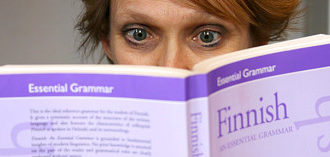There is a certain logic in thinking that languages spoken in neighbouring countries must be closely related. However, that’s not the case with Finnish.
Finnish speakers may run into questions like “Is Finnish like Swedish?” or “Does everyone in Finland speak Russian?” The simple answer to these questions is no (although Swedish is one of Finland’s official languages).
Both Swedish and Russian belong to the Indo-European group of languages, while Finnish is a Finno-Ugric language. The latter group also includes Hungarian, Estonian, Karelian and the Sámi languages (spoken by the Sámi Indigenous People, whose far-northern homeland is divided into four parts by the borders of the nation-states Finland, Sweden, Norway and Russia), as well as several languages spoken in areas of Russia. The Finno-Ugric languages share enough common lexical and grammatical features to prove a common origin.
Although these languages have developed separately for thousands of years, it can be seen that common features include:
1) absence of gender (the same Finnish pronoun, “hän,” denotes both “he” and “she”)
2) absence of articles (a and the in English)
3) long words due to the structure of the language
4) numerous grammatical cases
5) personal possession expressed with suffixes
6) postpositions in addition to prepositions
7) no equivalent of the verb “to have”
There are various theories about the time and place of the origin of the so-called Proto-Finno-Ugrian language. It seems that Hungarian and Finnish are separated by several thousand years of separate development.
How long Finnish speakers have populated Finland is a question that has always interested Finnish scholars. It is thought that speakers of a predecessor of Finnish arrived in what is now Finland approximately 1,500–2,000 years ago. Over time, contacts proliferated between Finno-Ugric speakers and speakers of neighbouring Indo-European languages, including Baltic, Germanic and Slavic dialects. Numerous loan words borrowed by Finnish, Estonian and the other Baltic Finnic languages (Karelian, Lude, Vepsian, Vote and Livonian) demonstrate the existence of contacts between people speaking Finnic languages and people speaking Indo-European languages. Most loan words in present-day Finnish have come from Germanic and Scandinavian languages, especially Swedish and, of course, English.
Modified from an article originally written by Hannele Branch










